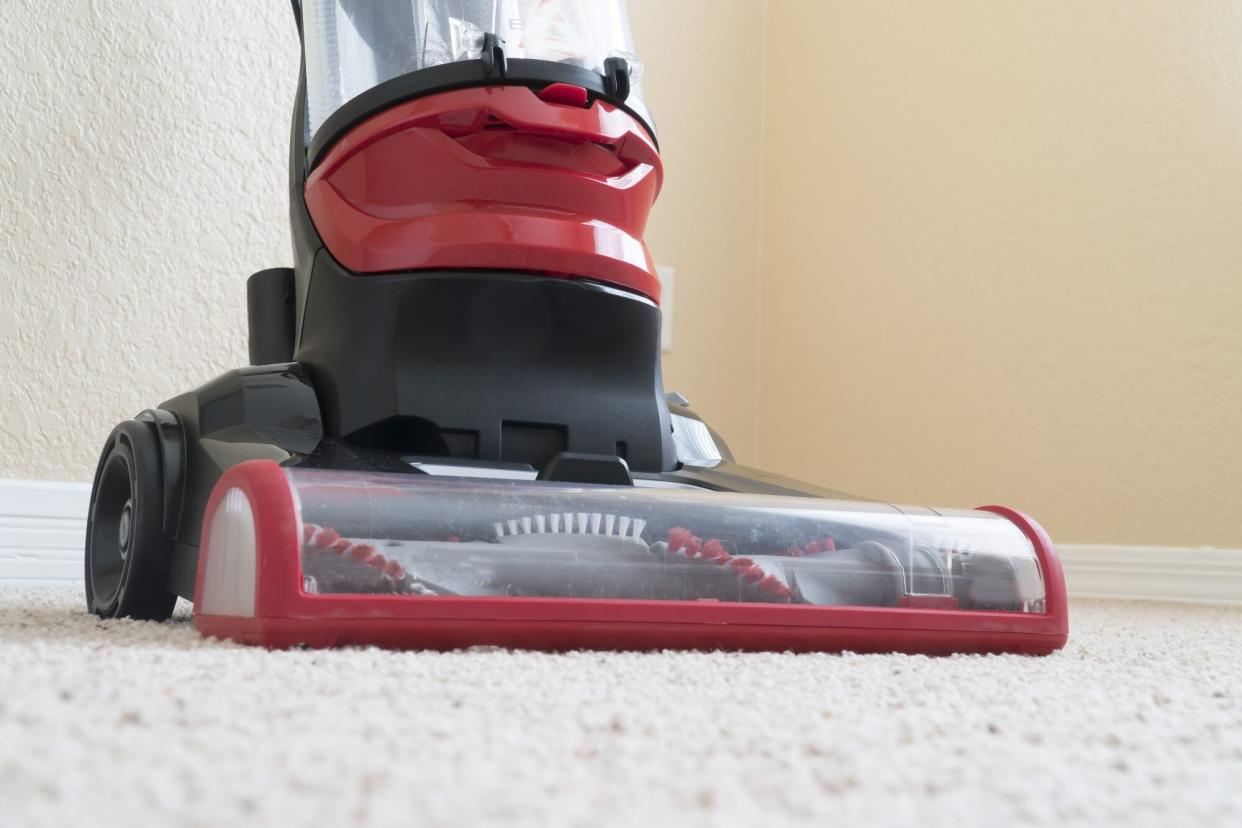Yes, You Need To Clean Your Vacuum—Here's Everything You Need To Know

Getty Images
Just like your living room rug needs a regular vacuum cleaning every few weeks, your actual vacuum needs some TLC every once in a while, too. If you've noticed that your vacuum isn't cleaning as effectively as it normally does (or like it used to), it's probably time for a proper vacuum cleaning. Below, we tapped two experts for their best tips on how to clean any vacuum.
How often should you be cleaning your vacuum?
According to Carlos Dorado Cardenas, Lead Systems Engineer at Dyson, the vacuum cleaning frequency depends on how often the machine is being used, but you can clean your vacuum bin, wand, attachments, and tools as often as you'd like. "It is recommended that you clean your vacuum filter at least once a month to keep your machine running at maximum efficiency," he suggests.
To get more specific, Allison Hogan, Product Manager at BLACK+DECKER, recommends a thorough cleaning of your vacuum one to two times per year, depending on usage. "Individual parts like filters, beater bars, and the dust bowl will need to be cleaned more frequently," she explains.
How to clean your vacuum
First of all, it's important to note that as a general guide for cleaning a vacuum, you should always refer to the specific manufacturer instructions before dismantling or washing your vacuum. That being said, there are some basic instructions to follow when cleaning your vacuum filter, as well as the other parts of your vacuum.
Vacuum filters should be cleaned off before every vacuum use, or when emptying the dust bowl. "Hand wash your filter one time per month at a minimum—it could be more depending on the use and if you are picking up fine debris, like dust," explains Hogan. Also, don't use soap when cleaning your filter. You want to replace your filter every six to nine months, depending on vacuum use, as clean filters are paramount in keeping good suction and airflow while vacuuming.
To clean the other parts of a stick vacuum, there are a few guidelines to follow:
First, remove the battery if it's a removable pack, or make sure the vacuum is not plugged in. Remove and empty the dust bowl, remove the filter, and leave all parts disassembled.
Then, remove the vacuum head from the extension pole and remove the floor head from the lower part of the extension pole.
Remove the beater bar from the floor head and clean off any hair that may have been wrapped around it
Remove accessories if they are on board or collect the accessories from their storage location.
Rinse dust bowl, accessories, and filter under running water to remove lingering dust and debris.
Use a damp cloth to clean where the dust bowl connects to the motorhead (but make sure to never put the motorhead under running water).
Use the damp cloth to clean over any crevices or areas that may have collected dust from storage or vacuuming.
"Compressed air can be useful for cleaning inside the extension pole," explains Hogan. "The pole should also never have water run through it, as there are electrical components inside—remove any visible hair that may have built up in the pole."
Allow all parts to completely dry before reassembling—the goal is to remove any buildup that may be interfering with airflow to keep your vacuum working at optimal performance.
For vacuums that are bagless, you'll need to have the dustbowl removed and washed out. "Users need to remove and wash (or replace) the filter," explains Hogan. "For stick vacuums, the floor head, extension pole, and motorhead can all be disassembled. This helps to easily access dust and debris that can get stuck as it is pulled from the floor/surface up through the unit and into the dust bowl." The beater bar can also usually be removed for easier cleaning of hair wrap, fuzz, and more. The other accessories like the extension hose, brushes, and crevice tools can all be washed as well.
When washing plastic components, the only two things you'll need are soap and water. "If you are cleaning a beater bar, a pair of scissors might come in handy to successfully remove hair," suggests Hogan.
What might happen to your vacuum if you don't clean it as often as you should?
A clogged filter means your vacuum cleaner won't work as effectively as it should. "A machine can claim to have high suction power, but without good dust-capturing technologies, filters will clog easily, and its performance will be compromised due to airflow blockage," says Cardenas. To help maintain optimum performance of your machine, he recommends emptying the bin as soon as the dirt reaches the max mark, regularly washing your filter using the instructions provided, and checking the brush bar on the cleaner head every month or so to ensure that no debris or hair has built up.
At what point should you consider purchasing a new vacuum?
According to Hogan, it's time to purchase a new vacuum when the vacuum no longer performs to your pick-up satisfaction or cannot do the application you need it to. "If you notice a decrease in suction power, it is key to see if the filter needs cleaning or replacing and also, that there are no clogs or blockages in the pole or floor head," she says.

